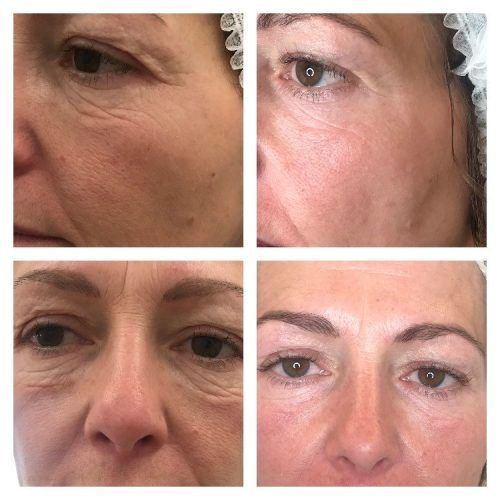HIFU Non-Surgical Facelift vs Surgical Facelift Rejuvenating Beauty Without Surgery
HIFU Non-Surgical Facelift vs Surgical Facelift. In the realm of beauty and skincare, technological advancements continually push the boundaries of what’s possible. Among these innovations, High-Intensity Focused Ultrasound (HIFU) has emerged as a groundbreaking non-surgical facelift option. Offering a safe, effective, and minimally invasive alternative to traditional facelift surgeries. HIFU has gained significant popularity in recent years.
In this comprehensive guide, we’ll delve into the intricacies of HIFU non-surgical facelift. Exploring its mechanism, benefits, potential side effects, and everything you need to know before considering this procedure.
Furthermore, we are going to look in depth at one common comparison which is HIFU Non-Surgical Facelift vs. Surgical Facelift
HIFU Non-Surgical Facelift Procedure:
The HIFU procedure typically begins with a consultation with a qualified skincare specialist or dermatologist. During this consultation, the practitioner will assess the patient’s skin condition, discuss treatment goals, and formulate a customized treatment plan.
Using a handheld device, the practitioner delivers focused ultrasound energy to the predetermined depths beneath the skin’s surface. The intensity and duration of the ultrasound energy may vary depending on the treatment area and desired outcomes. Throughout the procedure, the patient may experience mild discomfort or a tingling sensation, but it is generally well-tolerated.
HIFU Non-Surgical Facelift Advantages
One of the key advantages of HIFU is its precision targeting, allowing practitioners to deliver energy precisely to the intended areas without affecting the surrounding tissues. This minimizes the risk of damage and ensures optimal results with minimal downtime.

Benefits of HIFU Non-Surgical Facelift:
- Non-invasive: Unlike traditional facelift surgeries that involve incisions and anaesthesia, HIFU is non-invasive, requiring no cuts or sutures. This makes it a safer and more comfortable option for individuals seeking facial rejuvenation.
- Natural results: HIFU stimulates the body’s natural collagen production process, resulting in gradual and natural-looking improvements in skin tightness and elasticity. The results appear gradually over several weeks, with continued improvement seen over the following months.
- Minimal downtime: Since HIFU is a non-surgical procedure, it typically requires minimal downtime compared to traditional facelift surgeries. Most patients can resume their daily activities immediately after treatment, with no need for prolonged recovery periods.
- Versatility: HIFU can target various areas of the face and neck, including the forehead, eyebrows, cheeks, chin, jawline, and neck. This versatility allows practitioners to address specific concerns and customize treatment plans according to individual needs.
- Long-lasting results: While the initial results of HIFU may become apparent shortly after treatment, the full benefits continue to develop over time as collagen production increases. With proper skincare maintenance and occasional touch-up treatments, the results of HIFU can last for up to a year or more.
HIFU Facelft Potential Side Effects:
While HIFU is considered safe and well-tolerated, some potential side effects may occur, including:
- Temporary redness or swelling at the treatment site.
- Tingling or numbness
- Rarely, bruising or mild discomfort
These side effects are usually temporary and resolve within a few days following treatment. Remember, it’s essential to choose a qualified and experienced practitioner for HIFU treatments.

Comparing HIFU Non-Surgical Facelift vs Surgical Facelift
Facial aging is a natural process that often leads individuals to seek cosmetic interventions to restore a more youthful appearance. Two popular options for facial rejuvenation are the HIFU (High-Intensity Focused Ultrasound) non-surgical facelift and the surgical facelift. While both procedures aim to tighten and lift the skin, they differ significantly in terms of technique, invasiveness, recovery time, and overall outcomes.
We are going explore the key differences between HIFU non-surgical facelift and surgical facelift to help individuals make an informed decision about which option may be best suited to their needs.
As eve already taken a look at HIFU Non-Surgical Facelift, lets take some time to understand its surgical counterpart.

Surgical Facelift:
A surgical facelift, also known as rhytidectomy, is a more invasive procedure that involves making incisions, lifting and repositioning underlying tissues, and removing excess skin to achieve a more youthful appearance. Key characteristics of surgical facelift include:
- Invasive surgery: Surgical facelifts require incisions to be made, typically along the hairline and/or behind the ears, to access underlying tissues. The surgeon then lifts and repositions these tissues before trimming away excess skin.
- Longer recovery time: Compared to HIFU non-surgical facelift, surgical facelifts typically involve a longer recovery period. Patients may experience bruising, swelling, and discomfort for several weeks following surgery, and strenuous activities should be avoided during this time.
HIFU Non-Surgical Facelift vs Surgical Facelift
Comparison:
- Invasiveness: HIFU is minimally invasive, while surgical facelifts involve incisions and tissue manipulation under anaesthetic.
- Downtime: HIFU typically requires minimal downtime, whereas surgical facelifts involve a longer recovery period.
- Results: HIFU provides gradual improvements over time, while surgical facelifts offer more immediate and dramatic results.
- Longevity: HIFU results may last up to a year or more, while surgical facelift outcomes are generally considered more long-lasting.

HIFU Non-Surgical Facelift vs Surgical Facelift Conclusion:
Choosing between HIFU non-surgical facelift and surgical facelift depends on individual preferences, concerns, and goals. While HIFU offers a non-invasive option with minimal downtime and gradual results, surgical facelifts provide more immediate and dramatic outcomes with a longer recovery period. Ultimately, consulting with a qualified cosmetic surgeon or certified HIFU Techician is essential to determine the most suitable treatment approach based on individual needs and expectations. Whether opting for the convenience of HIFU or the transformative effects of surgery, both options can help individuals achieve a rejuvenated and more youthful appearance, enhancing their confidence and quality of life.
The decision is a deeply personal one and comes down to how you feel about surgery. For us, we are strong advocates of not having surgery unless it necessary, as such we have developed a service catalogue of effective non-surgical interventions. However, some still prefer surgery, and we respect that opinion to.
For those looking for harness the benefits of HIFU Non-Surgical Facelift, please click the button below.


Recent Comments